Abstract
Soleus H-reflex tests are used for elucidating pathophysiological mechanisms in motor control. The cumulative vibratory inhibition of the soleus H-reflex, the ratio of the reflex to direct muscle potential (H to M ratio) and the recovery curve of the soleus H-reflex were studied in 38 patients with varying signs of the upper motor neuron syndrome for a possible relation with clinical features. The results were compared with those obtained from a group of healthy volunteers. The magnitude of vibratory inhibition decreased with increase of hypertonia. The H to M ratio increased as the activity of the tendon reflex was enhanced and correlated to a lesser degree with muscle tone. Both the H to M ratio and late facilitation of the soleus H-reflex recovery curve were elevated in clonus. The findings suggest that alterations in the results of soleus H-reflex tests relate to specific clinical features of the upper motor neuron syndrome. Possible pathophysiological implications are discussed.
Full text
PDF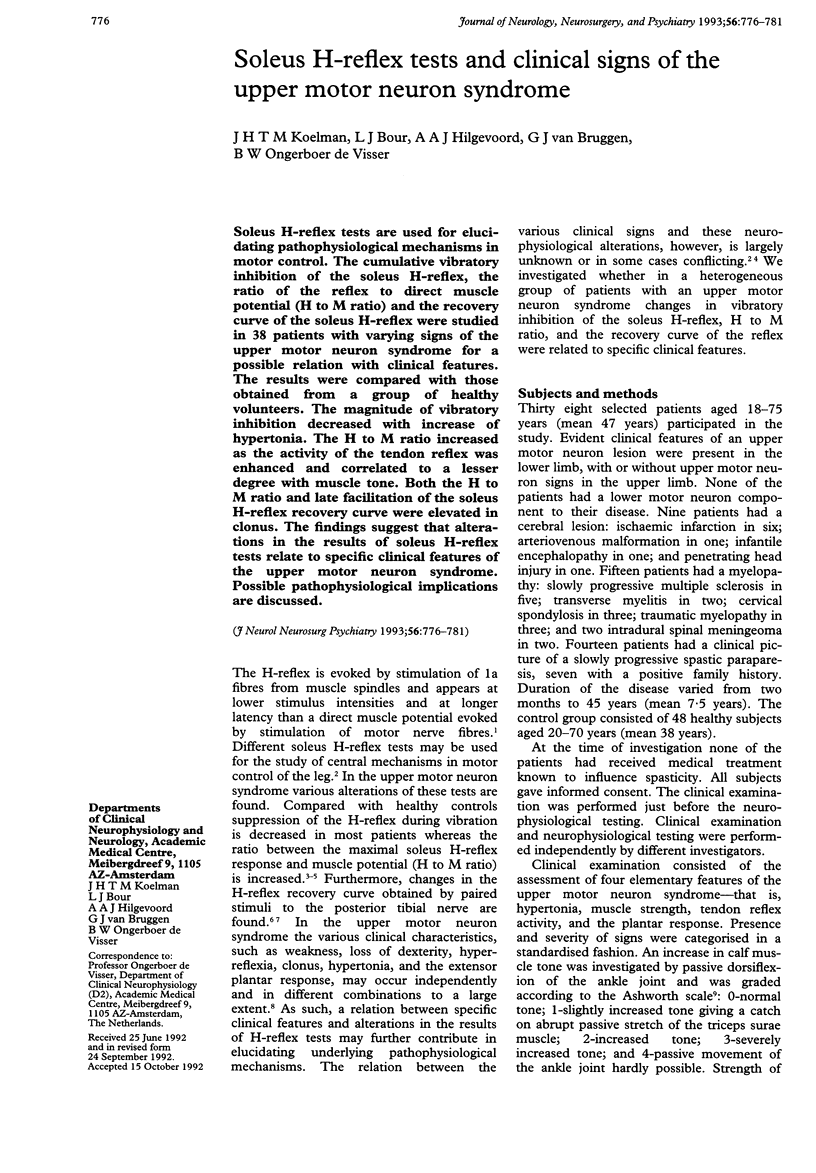
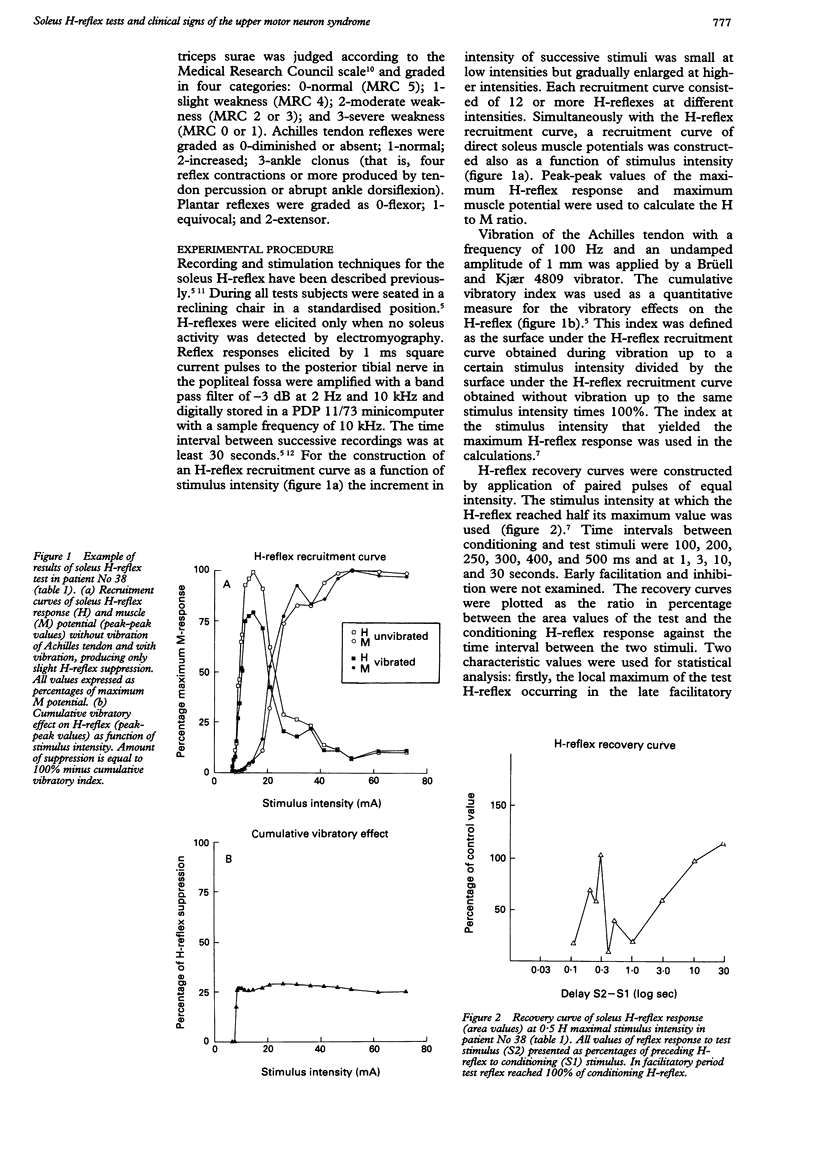
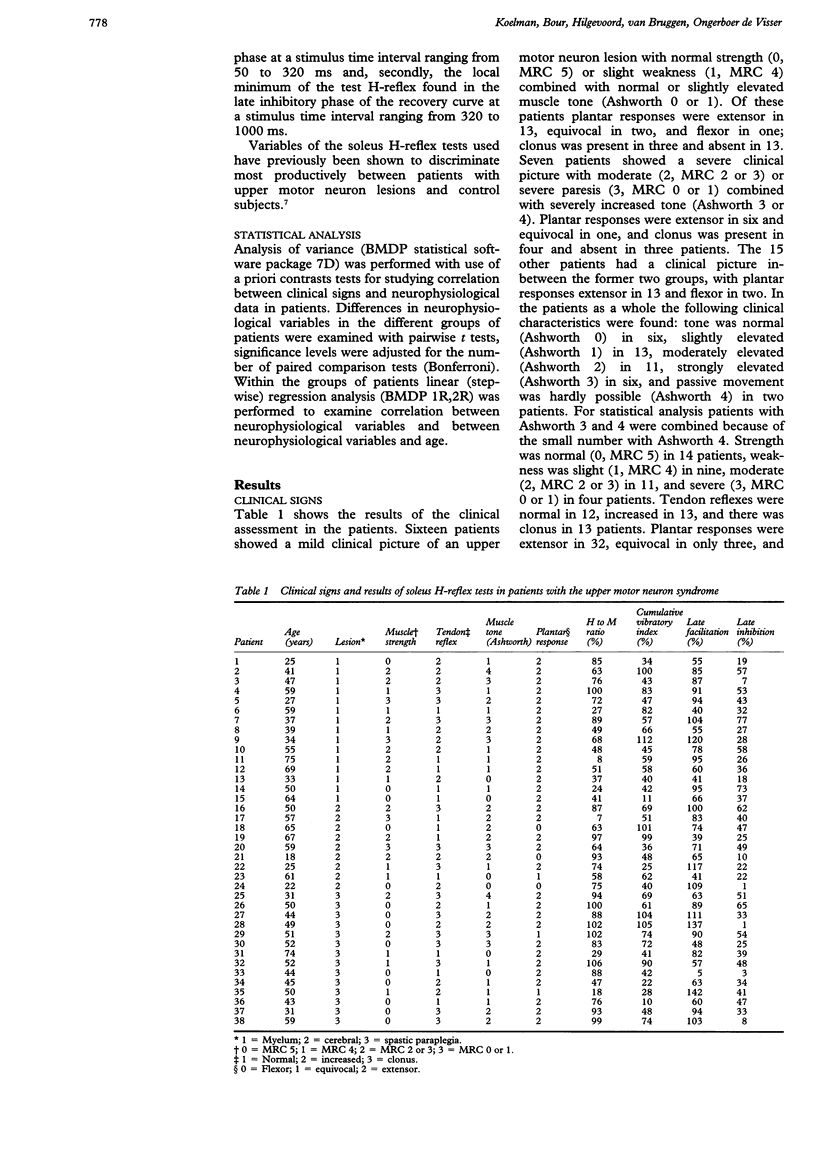
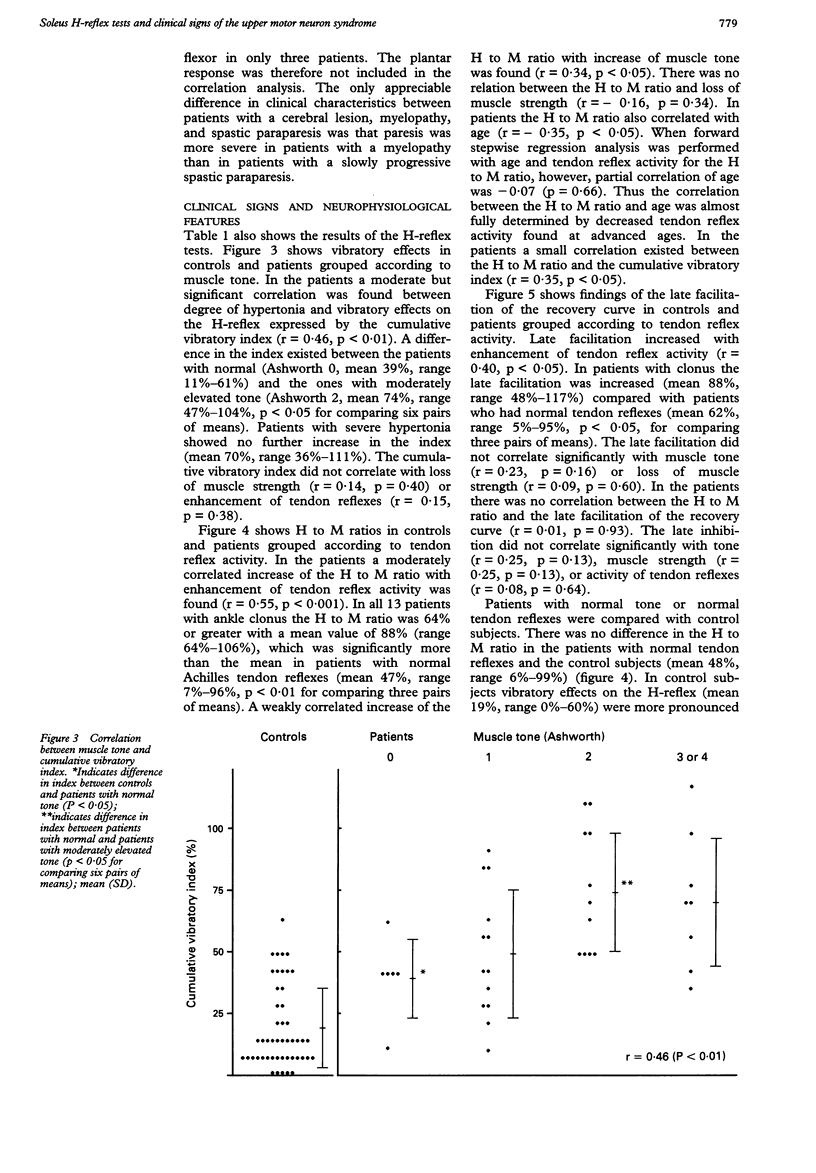
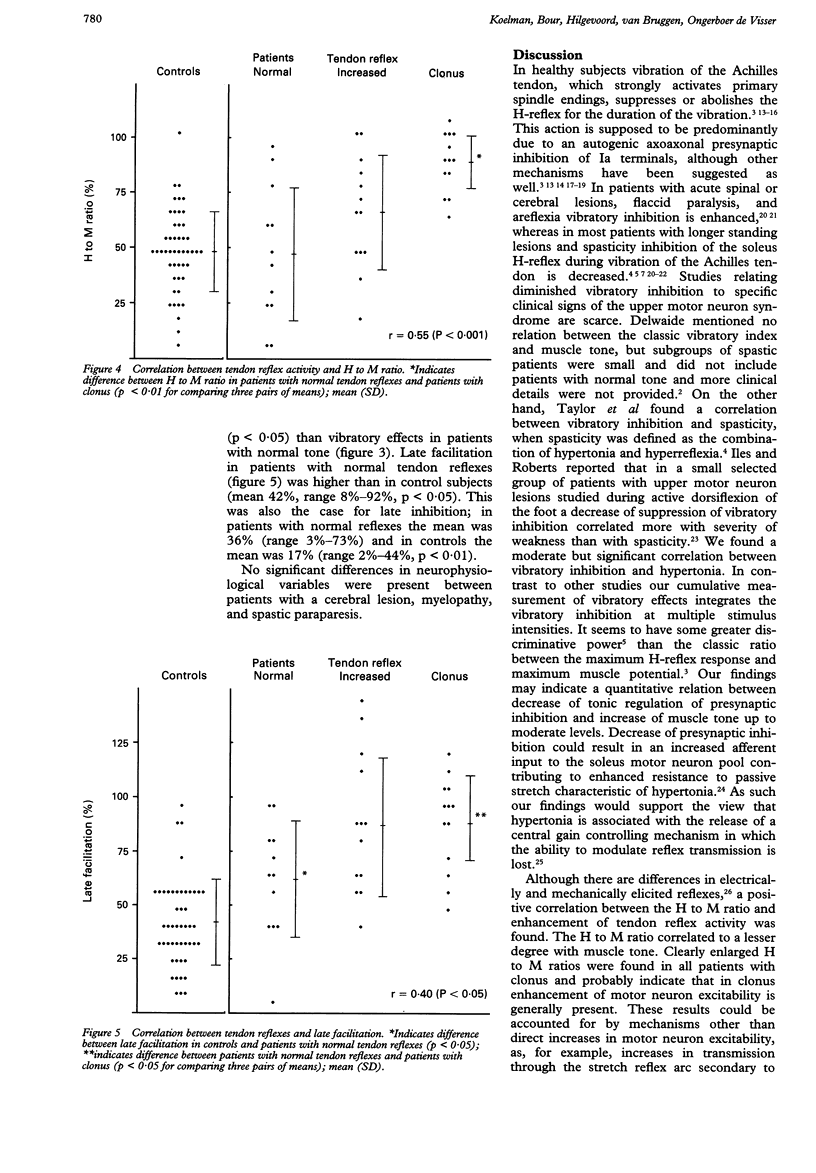
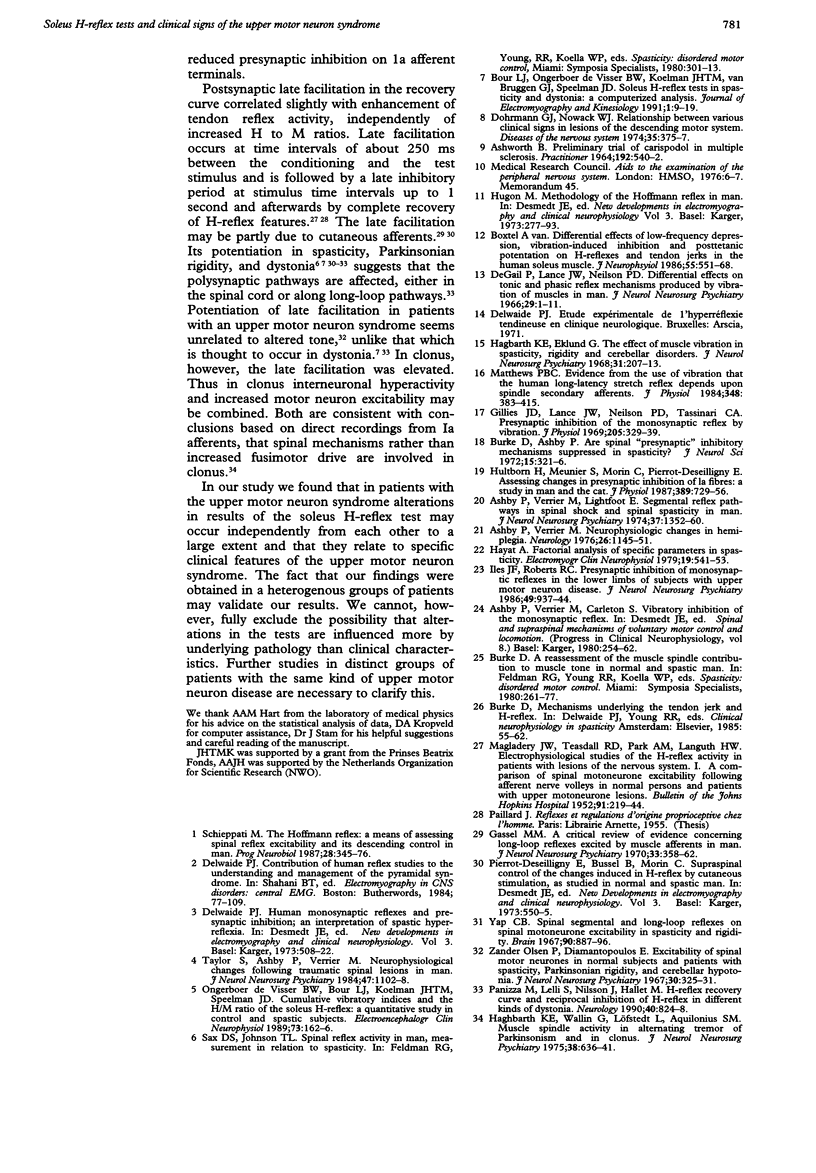
Selected References
These references are in PubMed. This may not be the complete list of references from this article.
- ASHWORTH B. PRELIMINARY TRIAL OF CARISOPRODOL IN MULTIPLE SCLEROSIS. Practitioner. 1964 Apr;192:540–542. [PubMed] [Google Scholar]
- Ashby P., Verrier M., Lightfoot E. Segmental reflex pathways in spinal shock and spinal spasticity in man. J Neurol Neurosurg Psychiatry. 1974 Dec;37(12):1352–1360. doi: 10.1136/jnnp.37.12.1352. [DOI] [PMC free article] [PubMed] [Google Scholar]
- Ashby P., Verrier M. Neurophysiologic changes in hemiplegia. Possible explanation for the initial disparity between muscle tone and tendon reflexes. Neurology. 1976 Dec;26(12):1145–1151. doi: 10.1212/wnl.26.12.1145. [DOI] [PubMed] [Google Scholar]
- Burke D., Ashby P. Are spinal "presynaptic" inhibitory mechanisms suppressed in spasticity? J Neurol Sci. 1972 Mar;15(3):321–326. doi: 10.1016/0022-510x(72)90073-1. [DOI] [PubMed] [Google Scholar]
- De Gail P., Lance J. W., Neilson P. D. Differential effects on tonic and phasic reflex mechanisms produced by vibration of muscles in man. J Neurol Neurosurg Psychiatry. 1966 Feb;29(1):1–11. doi: 10.1136/jnnp.29.1.1. [DOI] [PMC free article] [PubMed] [Google Scholar]
- Dohrmann G. J., Nowack W. J. Relationship between various clinical signs in lesions of the descending motor system (a statistical study). Dis Nerv Syst. 1974 Aug;35(8):375–377. [PubMed] [Google Scholar]
- Gassel M. M. A critical review of evidence concerning long-loop reflexes excited by muscle afferents in man. J Neurol Neurosurg Psychiatry. 1970 Jun;33(3):358–362. doi: 10.1136/jnnp.33.3.358. [DOI] [PMC free article] [PubMed] [Google Scholar]
- Gillies J. D., Lance J. W., Neilson P. D., Tassinari C. A. Presynaptic inhibition of the monosynaptic reflex by vibration. J Physiol. 1969 Nov;205(2):329–339. doi: 10.1113/jphysiol.1969.sp008968. [DOI] [PMC free article] [PubMed] [Google Scholar]
- Hagbarth K. E., Eklund G. The effects of muscle vibration in spasticity, rigidity, and cerebellar disorders. J Neurol Neurosurg Psychiatry. 1968 Jun;31(3):207–213. doi: 10.1136/jnnp.31.3.207. [DOI] [PMC free article] [PubMed] [Google Scholar]
- Hagbarth K. E., Wallin G., Löfstedt L., Aquilonius S. M. Muscle spindle activity in alternating tremor of Parkinsonism and in clonus. J Neurol Neurosurg Psychiatry. 1975 Jul;38(7):636–641. doi: 10.1136/jnnp.38.7.636. [DOI] [PMC free article] [PubMed] [Google Scholar]
- Hayat A. Factorial analysis of specific parameters in spasticity. Electromyogr Clin Neurophysiol. 1979 Nov-Dec;19(6):541–553. [PubMed] [Google Scholar]
- Hultborn H., Meunier S., Morin C., Pierrot-Deseilligny E. Assessing changes in presynaptic inhibition of I a fibres: a study in man and the cat. J Physiol. 1987 Aug;389:729–756. doi: 10.1113/jphysiol.1987.sp016680. [DOI] [PMC free article] [PubMed] [Google Scholar]
- Iles J. F., Roberts R. C. Presynaptic inhibition of monosynaptic reflexes in the lower limbs of subjects with upper motoneuron disease. J Neurol Neurosurg Psychiatry. 1986 Aug;49(8):937–944. doi: 10.1136/jnnp.49.8.937. [DOI] [PMC free article] [PubMed] [Google Scholar]
- MAGLADERY J. W., TEASDALL R. D., PARK A. M., LANGUTH H. W. Electrophysiological studies of reflex activity in patients with lesions of the nervous system. I. A comparison of spinal motoneurone excitability following afferent nerve volleys in normal persons and patients with upper motor neurone lesions. Bull Johns Hopkins Hosp. 1952 Oct;91(4):219–passim. [PubMed] [Google Scholar]
- Matthews P. B. Evidence from the use of vibration that the human long-latency stretch reflex depends upon spindle secondary afferents. J Physiol. 1984 Mar;348:383–415. doi: 10.1113/jphysiol.1984.sp015116. [DOI] [PMC free article] [PubMed] [Google Scholar]
- Olsen P. Z., Diamantopoulos E. Excitability of spinal motor neurones in normal subjects and patients with spasticity, Parkinsonian rigidity, and cerebellar hypotonia. J Neurol Neurosurg Psychiatry. 1967 Aug;30(4):325–331. doi: 10.1136/jnnp.30.4.325. [DOI] [PMC free article] [PubMed] [Google Scholar]
- Ongerboer de Visser B. W., Bour L. J., Koelman J. H., Speelman J. D. Cumulative vibratory indices and the H/M ratio of the soleus H-reflex: a quantitative study in control and spastic subjects. Electroencephalogr Clin Neurophysiol. 1989 Aug;73(2):162–166. doi: 10.1016/0013-4694(89)90196-x. [DOI] [PubMed] [Google Scholar]
- Panizza M., Lelli S., Nilsson J., Hallett M. H-reflex recovery curve and reciprocal inhibition of H-reflex in different kinds of dystonia. Neurology. 1990 May;40(5):824–828. doi: 10.1212/wnl.40.5.824. [DOI] [PubMed] [Google Scholar]
- Schieppati M. The Hoffmann reflex: a means of assessing spinal reflex excitability and its descending control in man. Prog Neurobiol. 1987;28(4):345–376. doi: 10.1016/0301-0082(87)90007-4. [DOI] [PubMed] [Google Scholar]
- Taylor S., Ashby P., Verrier M. Neurophysiological changes following traumatic spinal lesions in man. J Neurol Neurosurg Psychiatry. 1984 Oct;47(10):1102–1108. doi: 10.1136/jnnp.47.10.1102. [DOI] [PMC free article] [PubMed] [Google Scholar]
- Van Boxtel A. Differential effects of low-frequency depression, vibration-induced inhibition, and posttetanic potentiation on H-reflexes and tendon jerks in the human soleus muscle. J Neurophysiol. 1986 Mar;55(3):551–568. doi: 10.1152/jn.1986.55.3.551. [DOI] [PubMed] [Google Scholar]
- Yap C. B. Spinal segmental and long-loop reflexes on spinal motoneurone excitability in spasticity and rigidity. Brain. 1967 Dec;90(4):887–896. doi: 10.1093/brain/90.4.887. [DOI] [PubMed] [Google Scholar]


